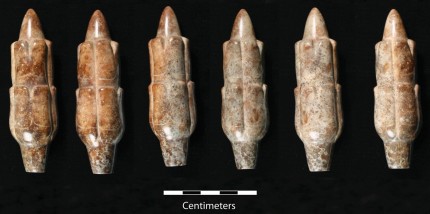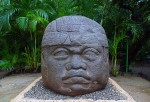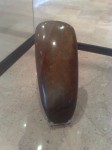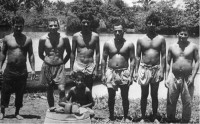Underwater archaeologists exploring a stream in the Arroyo Pesquero site in southern Veracruz, Mexico, have discovered a unique Olmec artifact carved out of jadeite that appears to be a stylized corncob. The small object is 8.7 centimeters high by 2.5 centimeters wide (3.4 inches by 1 inch) and is made of mottled orangey brown and white jadeite. It is highly polished and is carved in smooth relief with some scratched incised lines. At the base is tapering cylinder that was broken at some point and was smoothed afterwards. Above the base the object has three sides divided by grooves, each side carved with two rectangular stacked shapes that have v-shaped clefts in the center top. At the bottom of each rectangle is a scratched incision in a scalloped shape. At the top of the object is a tapered cone emerging from the top row of clefts.

Cleft rectangles with cones emerging from them are relatively common in Middle Formatic Olmec iconography, but this piece is unique because the cleft rectangles are stacked instead of being a single individual and because they are carved in three dimensions in the round. Many Olmec scholars contend that cleft rectangles represent an ear of corn, but if that is accurate in this case, the artifact depicts six stacked ears of corn with an ear of an entirely different shape rising from the top of the stack. The archaeologists who found and published the artifact in the journal Ancient Mesoamerica believe that the cleft rectangles represent corn kernels, perhaps of seed corn, which would make the conical element on top a representation of the corn plant as it grows from seed. It could also be a husked corn cob. If their reading is correct, the standard interpretation of corn elements in Olmec iconography will have to be revised.
 Archaeologists date it to the Olmec Middle Formative period (900–400 B.C.). No Olmec buildings from that period have been discovered at Arroyo Pesquero above or below ground, but just 10 miles northeast lies the Olmec center of La Venta which at its peak during the Middle Formative had a population of 10,000 and is renown for its 112-foot-high Great Pyramid, mosaic pavements and monumental sculptures including four of the colossal heads most associated with Olmec culture.
Archaeologists date it to the Olmec Middle Formative period (900–400 B.C.). No Olmec buildings from that period have been discovered at Arroyo Pesquero above or below ground, but just 10 miles northeast lies the Olmec center of La Venta which at its peak during the Middle Formative had a population of 10,000 and is renown for its 112-foot-high Great Pyramid, mosaic pavements and monumental sculptures including four of the colossal heads most associated with Olmec culture.
In addition to its one-of-a-kind iconographic approach and three-dimensional form, this artifact is unique for having been the first found at Arroyo Pesquero as part of a systematic archaeological investigation. The underwater archaeological site of Arroyo Pesquero was discovered by a local fisherman in 1969 who was searching in a deep stream for a metal basin that had been dropped by the son of a friend when he was at stream collecting fresh water for the family’s use. In the course of looking for the basin, he found stone masks, anthropomorphic figurines, celts (smooth axes). Archaeologist Manuel Torres Guzman heard about it and visited the site in 1970, hiring divers to retrieve thousands more stone artifacts and pyrite mirrors from the streambed.
 Since then, the site has been a magnet for local and foreign artifact looters. There was only one other official archaeological exploration of the Arroyo Pesquero site: a week-long expedition in 1986 that aimed to recover objects for the new Museo de Antropologia de Xalapa. They found some pottery sherds downstream of where the masks were found in ’69 and that’s it. Artifacts discovered at Arroyo Pesquero are now in the Museo de Antropologia de Xalapa, the Museum de la Universidad de Veracruz and in major museums and private collections all over Mexico, the United States and Europe.
Since then, the site has been a magnet for local and foreign artifact looters. There was only one other official archaeological exploration of the Arroyo Pesquero site: a week-long expedition in 1986 that aimed to recover objects for the new Museo de Antropologia de Xalapa. They found some pottery sherds downstream of where the masks were found in ’69 and that’s it. Artifacts discovered at Arroyo Pesquero are now in the Museo de Antropologia de Xalapa, the Museum de la Universidad de Veracruz and in major museums and private collections all over Mexico, the United States and Europe.
In 2005, archaeologists Carl Wendt and Roberto Lunagómez initiated the Proyecto Arqueológico Arroyo Pesquero (PAAP), a research program to collect survey data and excavate a number of Olmec sites in the Arroyo Pesquero area. It was the first underwater archaeology work done in Veracruz. Since then PAAP has completed a regional reconnaissance survey and seven years of fieldwork. The 2012 season focused on the Arroyo Pesquero streambed where the Olmec artifacts were discovered in 1969. The goal was to map the topography of the underwater surface and to record the presence and distribution of artifacts.
Between April and May of 2012, PAAP divers braved atrocious underwater conditions — zero visibility and obstructions including large logs, debris, decomposing leaves and assorted other vegetation — to measure the streambed features, precisely note artifact positions using sub-meter GPS and recover a few them. The corncob was the most significant of the finds. It was recovered from a shallow depression on the bed between two and three meters under the water’s surface.
 Given the great numbers of artifacts found at the bottom of the freshwater stream, archaeologists believe the site held religious significance to the Olmecs. The cache spot is in a point of the stream where fresh and brackish water meet. If this confluence of fresh water necessary to sustain human life and salt water necessary to sustain the life that helps sustains human life was in the same location 2,500 or so years ago, that would make it an ideal place for votive offerings. In many Mesoamerican cultures, springs, cenotes, watery caves were held as sacred, entrance points between the underworld and our living earth. People would leave offerings and make sacrifices to the gods in these hallowed places.
Given the great numbers of artifacts found at the bottom of the freshwater stream, archaeologists believe the site held religious significance to the Olmecs. The cache spot is in a point of the stream where fresh and brackish water meet. If this confluence of fresh water necessary to sustain human life and salt water necessary to sustain the life that helps sustains human life was in the same location 2,500 or so years ago, that would make it an ideal place for votive offerings. In many Mesoamerican cultures, springs, cenotes, watery caves were held as sacred, entrance points between the underworld and our living earth. People would leave offerings and make sacrifices to the gods in these hallowed places.
The corncob, symbol of abundance, life, power and authority, would make for a powerful offering. Archaeologists aren’t certain how it was originally used. The bottom is truncated and was smoothed over after the breakage. It could have been a finial topping a scepter or staff carried, as one sees often in Olmec art, in one hand by individuals presented as lords or rulers. It could also hae been the handle of a perforator (aka a blood-letter) which was deliberately broken and then refinished at the break point. Or it could just be a portable figurine representing corn.
Whatever its use, its symbolism was powerful. Depositing such a representation of abundance and strength at the spot where salt and fresh water meet would have been a highly meaningful offering, all the more so because the coastal region is replete with salt water while freshwater sources are rare.